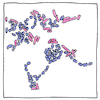Hans Christian Gram
bacteriology

|
Gram staining
Gram staining makes bacteria visible and can help to quickly identify the bacterial species. Gram-positive bacteria have thick outer cell walls of peptidoglycan that can be stained with a crystal violet dye. Gram-negative bacteria resist the violet dye but can be counterstained red or pink with safranin or fuchsine.
Gram-related
Bacteria are categorized by gram staining, shape, envelope organization, and RNA phylogenetic studies. Gram staining positive or negative does not necessarily mean the bacterial species are genetically related. Insert gobbledeegook here.
Tests
The test of effort— a stained sleeve. The test of fidelity— lipstick on the collar. The test of housekeeping— ring in the tub. The test of experience— worry lines. Picking berries— stained hands. Gardening— dirt under the nails. Cleaning fish— scales stuck to sleeves. History of science— others who understand.



The total number of bacterial species can only be estimated. One source says there are between ten million and a billion species of bacteria. For comparison, there are fewer than a third of a million species of plants.
See also in The book of science:
Readings in wikipedia: